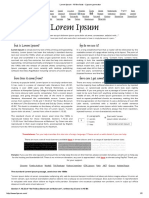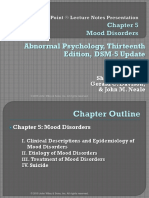Depersonalization - Depersonalization Research Unit
Depersonalization - Depersonalization Research Unit
Uploaded by
Rudra Pradeepta Sharma KCopyright:
Available Formats
Depersonalization - Depersonalization Research Unit
Depersonalization - Depersonalization Research Unit
Uploaded by
Rudra Pradeepta Sharma KOriginal Description:
Copyright
Available Formats
Share this document
Did you find this document useful?
Is this content inappropriate?
Copyright:
Available Formats
Depersonalization - Depersonalization Research Unit
Depersonalization - Depersonalization Research Unit
Uploaded by
Rudra Pradeepta Sharma KCopyright:
Available Formats
Cutting edge
Depersonalisation
Depersonalisation
Founded in 1998, the DEPERSONALISATION RESEARCH UNIT at the Institute of Psychiatry was the first in its field.
Now the team describe their progress in the development of cognitive-behavioural and pharmacological treatments.
EPERSONALISATION is
a psychiatric condition
characterised by an alteration in
the perception and experience of the self
(Mellor, 1988). It was first described in the
scientific literature over one hundred years
ago (for a historical review see Sierra &
Berrios, 1997) and has a prevalence in the
general population that has been estimated
to be as high as 3 per cent (Trueman,
1984).
Imagine being constantly out of touch
with your own feelings and senses: this is
similar to depersonalisation disorder.
Sufferers of this disorder experience
a sense of unreality and detachment
from various aspects of themselves, which
manifests itself as a sense of disconnection
from ones own body, cognition or affective
state (DSM-IV: APA, 1994). Clinical
sufferers sometimes self-mutilate in an
attempt to feel themselves, such is the
severity of the condition. Whilst
depersonalisation can occur as a primary
symptom (Ballard et al., 1992), it can also
occur as secondary to neurological
conditions such as epilepsy or Mnires
disease. It is also sometimes seen in
conjunction with other psychiatric
conditions, such as panic disorder,
depression, schizophrenia and obsessive
compulsive disorder (Sedman & Kenna,
1963; Sedman & Reed, 1963). In addition,
depersonalisation can occur in healthy
individuals after taking drugs such as
cannabis or Ecstasy (McGuire et al., 1994;
Szymanski, 1981) and has been reported
during near-death experiences (Noyes
et al., 1976).
Surprisingly, there have been few
contemporary investigations into
depersonalisation and fewer still into the
WEBLINKS
Depersonalisation Research Unit:
www.iop.kcl.ac.uk/depersonalisation
Depersonalisation bulletin board:
depersonalization.hypermart.net/
development of possible treatments. This
lack of study led to the establishment in
1998 of the Depersonalisation Research
Unit at the Maudsley Hospital in London.
Its mission statement was twofold. First, to
initiate research into the disorder; secondly,
to develop effective treatment strategies,
both pharmacological and psychological.
In addition, collection and dissemination
of information about depersonalisation is
carried out. This is done through the units
website (see Weblinks box) and through an
information sheet that is sent to sufferers
and clinical practitioners alike.
Some of the depersonalisation sufferers
referred to the unit have participated in
a drug trial to investigate the efficacy of
treatment with the anticonvulsant
lamotrigine through its potential antidissociation effects. A further group
have participated in the development of
a cognitive-behavioural therapy regime,
whilst several other individuals have taken
part in a number of functional
neuroimaging and psychophysiological
investigations.
In addition to these treatment
programmes, a group of people suffering
from the disorder were recruited through
the internet, and a comparison was made
between an online population and one
from the units clinic. The database of
responses will help to characterise the
disorder this article summarises these
investigations. But first we give examples
of psychological theories that have been
developed to describe depersonalisation.
Psychological theories
of depersonalisation
Early psychologists believed that
depersonalisation was caused by sensory
disturbances in different modalities (the
visual modality being the most frequently
affected). However, contemporary theories
ascribed depersonalisation to an alteration
of body sensation per se (i.e.
coenaesthesia). In recent years Damasio
has proposed that the continuous
bombardment of consciousness with bodily
signals creates a sensory background
crucial to determining a sense of self.
This would imply that a disruption of
this sensory background could result
in depersonalisation (Damasio, 1996).
The view that depersonalisation could
be explained as a consequence of a
malfunction in individual mental functions
(i.e. mental faculties) became dominant
during the second half of the 19th century.
Different researchers proposed theories
based on a primary dysfunction of memory,
emotions or body image (this being
a variation of the coenaesthesia theory).
All these theories had a major drawback
an inability to account for many of the
components (e.g. affective dampening
or visual disturbances) of the
depersonalisation syndrome (see Sierra
& Berrios, 1997, for a review).
The turn of the century marked a
departure from the above reductionist
views, and higher levels of complexity
were adopted. Thus, depersonalisation was
explained as the result of the loss of a brain
mechanism that causes the feeling of
mental experiences and their attribution to
the self. A similar view, endorsed by the
German philosopher and psychiatrist Karl
Jaspers, related depersonalisation to a
pathological change in the activity of the
self (a mechanism that is mediated by the
feeling of self-belonging) (Jaspers,
1913/1963). These views are still present,
in various forms, in the current
understanding of depersonalisation as
a dissociative disorder.
However, being cast at such high level
of complexity (i.e. that of the self and selfconsciousness), these theories are hardly
amenable to psychological or
neurobiological testing. Psychological
theories that are amenable to empirical
investigation are those that consider
depersonalisation to be a pre-formed
functional response of the brain to threat or
overwhelming anxiety. Such a response is
assumed to enhance chances of survival in
life-threatening situations by heightening
alertness and dampening potentially
disorganising levels of anxiety (MayerGross, 1935; Noyes et al., 1977).
128
The Psychologist
Vol 14 No 3
March 2001
Depersonalisation
Indeed there now exists a substantial
body of literature demonstrating a link
between experiencing trauma and various
types of dissociative response (e.g. Chu
& Dill, 1990). Depersonalisation disorder,
with its state of heightened arousal
combined with a dampening of emotional
response, is widely viewed as a defence
mechanism in the face of severe stress, lifethreatening situations or trauma. However,
although this response may have been
adaptive in the short or medium term,
patients describe themselves as unable to
switch off this response and feel unable
to return to their premorbid state.
To illustrate how the disorder affects
individuals, two vignettes of patients seen
in the clinic are now presented (see boxes).
Details have been changed to protect their
anonymity. Patient A presented with the
syndrome as a complication of epilepsy;
Patient B was more typical, with comorbid
anxiety and depression.
The Maudsley database
To date the database contains information
from well over 100 respondents. Of this
number, two thirds are patients who have
been referred to the unit, approximately
20 contacted the unit via our internet site,
and a similar number contacted the unit
in response to an article published in The
Times in March 1998.
In our sample, depersonalisation is
experienced in roughly equal proportions
by both men and women. Those contacting
the unit tend to be high academic
achievers, with a figure of nearly 70 per
cent going on to further education after
secondary school suggesting possible
selection or referral biases. However,
nearly a third of the group are currently
unemployed, a figure signifying the
impairment in functioning which can
result from depersonalisation disorder.
Clinical questionnaires indicated a
moderate level of dysfunction, with mean
depression and anxiety scores just above
the clinical cut-offs. On the Dissociative
Experiences Scale (DES) (Bernstein &
Putnam, 1986) the group scored relatively
highly with a mean score of 21 (compared
with normal adult scores of 48).
Comorbidity with other psychological
disorders was high, with respondents
reporting diagnoses of depression, anxiety
disorders, and even schizophrenia.
The database is continually being
updated from new referrals. As such it
represents a valuable source of information
concerning the disorder. In addition to
demographic and clinical information, the
database contains responses from a range
of psychometric questionnaires. These
provide details on many other factors
such as visual imagery and self-perception,
which may well prove to be related to
depersonalisation and we hope will
generate useful insights and avenues
for future research.
It is widely acknowledged that
depersonalisation can often coexist with
DSM Axis I psychiatric conditions such
as depression and anxiety (i.e. secondary
depersonalisation) (Cassano et al., 1989).
It is also accepted that symptoms of
PATIENT B
A 30-year-old male with a family history of
panic disorder and alcohol abuse developed
depersonalisation after a panic attack. His
depersonalisation was constant and was
exacerbated by various factors, such as reading,
where he reported being intensely depersonalised
afterwards, and consuming alcohol, after which he
reported being very blurred. He also reported
being very distant from the real world, and said
when he touched someone it doesnt feel as
if I am really touching them.
This patient maintained that the depersonalisation
feeling was always in my head, even when my
eyes are closed, and reported the complete loss
of visual imagery abilities. He was placed on the
antidepressants fluoxetine and later sertraline,
which resulted in improvement in depersonalisation.
However, residual symptoms remained, which have
interfered with work and social functioning.
depression and anxiety may develop in
those with primary depersonalisation,
(Nemiah, 1989). However, the frequency
with which primary and secondary
depersonalisation occurs is not known.
The DES has three subscales, one of
which assesses depersonalisation/
derealisation. A recent analysis of the DES
revealed eight items that are specific to the
detection of depersonalisation (see box);
the rest are specific to dissociation,
amnesia, and so on. We found that the DES
and its subscales correlated with depression
and, to a lesser extent, anxiety (assessed
PATIENT A
DISSOCIATIVE EXPERIENCES SCALE
A 22-year-old right-handed woman with
The DES (Bernstein & Putnam, 1986) is scored by indicating the percentage of time a particular event
happens to you.The items of the scale found to be specific to depersonalisation (Simeon et al., 1998) are:
a family history of depression developed
Some people have the experience of finding themselves in a place and having no idea how they
got there.
Some people have the experience of finding new things among their belongings that they do not
remember buying.
Some people sometimes have the experience of feeling as though they are standing next to
themselves or watching themselves do something, and they actually see themselves as if they
were looking at another person.
Some people are told that they sometimes do not recognise friends or family members.
Some people have the experience of feeling that other people, objects, and the world around
them are not real.
her surroundings and other people were not
Some people have the experience of feeling that their body does not seem to belong to them.
real, as though she was watching television.
Some people find that in one situation they may act so differently compared with another situation
that they almost feel as if they were two different people.
Some people find that they hear voices inside their head that tell them to do things or comment
on things that they are doing.
partial epilepsy at 17 years.The seizures were
medically intractable, so she underwent a leftsided temporal lobectomy at the age of 18.
Neuroimaging confirmed the compete
removal of the medial temporal structures.
Eighteen months later her seizures recurred,
consisting of a thumping sensation in her
head, fear, panic and depersonalisation. She felt
that she wasnt there, that she was not real
and that she was in a dream. She also felt that
Increasing her anticonvulsant medication
stopped the episodes of depersonalisation
but not the panic.
129
March 2001
The Psychologist
Vol 14 No 3
Depersonalisation
using the Beck Anxiety and Depression
Inventories). However, the DES and
subscale scores were not able to
differentiate between patients with primary
and those with secondary depersonalisation.
This generates doubt about the validity of
this distinction based on psychopathological
ratings alone, and reveals that some level of
depression and anxiety is observed even in
primary cases of depersonalisation
(Lambert et al., in press).
Neuroimaging and
psychophysiological studies
The active inhibition of emotional
processing has been suggested in a model
underlying some of the clinical features of
depersonalisation (Sierra & Berrios, 1998).
In brief, this model suggests that the
medial prefrontal cortex exerts an
inhibitory effect on subcortical limbic
structures which are involved in generating
normal emotional responses (including the
insula) (Phillips et al., 1999). Patients will
frequently state that although they are
aware of the normal emotional responses
to particular situations, they do not really
feel the emotions and are going through
the motions of an emotion. This can be
seen as part of the broader complaint of
the disorder: that for sufferers the world
around them lacks vividness and
immediacy. To understand this further,
functional neuroimaging and
psychophysiological techniques were used
in a number of studies to investigate the
processing of affective material in those
with depersonalisation disorder.
In the first study the skin conductance
response of patients with chronic
depersonalisation and age- and sexmatched normal controls was recorded
when the participants were shown pictures
with different emotional valence. These
were neutral, pleasant or unpleasant (e.g.
pictures of abstract art, a group of puppies
playing, a shark attack). The amplitude of
event-related responses to the unpleasant
pictures was significantly reduced in the
depersonalised patients. This suggests that
people suffering from depersonalisation
have a reduced autonomic response to
unpleasant stimuli.
To investigate the possible neural
underpinnings of this impairment in
autonomic processing, functional
neuroimaging experiments were also
carried out. We compared depersonalisation
disordered patients with both healthy
volunteers and clinical control patients
(i.e. individuals with obsessive compulsive
disorder). We predicted that depersonalised
patients would rate aversive scenes as less
emotional, would demonstrate reduced
activation in emotion-specific regions of
the brain (such as the insula), and would
demonstrate increased activation in regions
implicated in the inhibition of the
emotional response (inferior frontal
cortex).
This pattern of results would provide
some evidence for the symptom of
depersonalisation as a coping response to
overwhelming anxiety, with the ability to
experience a state of high emotional
arousal switched off when a potentially
distressing or threatening stimulus is
encountered. This would lend some
empirical support to the theoretical model
proposed by Sierra and Berrios (1998).
The results gathered so far support these
predictions. Patients suffering from
depersonalisation rate the aversive pictures
as producing the same intensity of
130
The Psychologist
Vol 14 No 3
March 2001
Depersonalisation
emotional experience as the neutral ones.
The pattern of neural activity for both the
healthy participants and the obsessive
compulsive disorder patients was similar,
with the aversive scenes activating the
insula. However, the aversive scenes did
not activate this region in the
depersonalised patients. Instead a greater
neural response (more activity) to the
neutral scenes was demonstrated in these
areas (Phillips et al., 2000).
A final study, currently in progress,
aims to build on the finding described
above by examining the neural processes
underlying emotional memory both in
healthy participants and in those with
depersonalisation. Emotional memory has
become a key area in affective
neuroscience, due in part to its relevance in
a range of psychiatric disorders including
post-traumatic stress disorder, depression,
and phobias. We are currently using stimuli
specifically designed to examine the recall
of emotional and neutral information from
affective contexts. A previous pilot study
carried out on healthy participants has
shown a differential neural response to,
on the one hand, direct emotional recall
(recalling an emotional word, e.g. raped)
and, on the other hand, contextual recall
(recalling the sentence the word was read
in, e.g. the sailor raped the girl in the
alley) (Medford et al., 2000). We are
currently using the same technique to
examine these neural processes in the
context of depersonalisation.
Using the internet as a
research tool
Recent psychological investigations carried
out on the internet have replicated results
from standard laboratory and pen-andpaper studies (for reviews see Senior et al.,
1999; Senior & Smith, 1999). These
studies suggest that the internet is a viable
medium for psychological research,
although its role in clinical research has
only just begun to be explored (see Senior
et al., 1997; Smith & Senior, 2001).
We wanted to assess the utility of the
internet for clinical research into
depersonalisation. To do this we compared
the scores of several clinical and demographic
questionnaires between participants
recruited on the depersonalisation bulletin
board (see Weblinks) and the units
outpatient clinic. We predicted that the
general demographics and clinical
psychometric scores between the two
groups would be the same.
All participants were asked to provide
details of their history of depersonalisation
including duration of illness and
medication, along with demographic details
(age, sex, years in education). Patients
attending the depersonalisation clinic were
assessed by one of the units psychiatrists.
Participants recruited via the internet were
contacted and interviewed by telephone.
Demographics, details of depersonalisation
(duration and severity) and scores of the
clinical questionnaires were equivalent,
supporting the utility of the internet in
the investigation of depersonalisation.
In addition to this, we wanted to
determine whether useful clinical
information regarding the aetiology,
clinical characteristics and response to
treatment could be obtained using the
internet. This was carried out by posting a
series of questions on the depersonalisation
bulletin board. In general, the information
acquired from the responses to the bulletin
board postings was consistent with prior
knowledge about the aetiology and
phenomenology of depersonalisation.
In summary, the internet users found
the depersonalisation website to be easy to
access and helpful as a supportive network.
The anonymity was an important aspect
and many had used it to help establish or
confirm their diagnosis and to discuss
treatment. Some participants responding
from the USA commented that they had
not seen a specialist because of lack of
funds. The internet would therefore appear
to be an effective way of disseminating
information as well as recruiting
participants for research who would
otherwise not have reached medical
attention (Lambert et al., 2000).
Pharmacological and cognitivebehavioural treatment
Preliminary evidence suggests that
lamotrigine (the anticonvulsant medication,
used mostly to treat epilepsy) can reduce
the intensity of ketamine-induced
depersonalisation (Anand et al., 2000).
Street users of ketamine experience out-ofbody sensations that are similar to clinical
depersonalisation. They are, however,
transient, whilst a majority of the primary
depersonalisation clinical cases that we see
are permanent.
Based on these findings we tested
lamotrigine in patients with
depersonalisation disorder. Those from
the units outpatient clinic with chronic,
continuous depersonalisation disorder were
asked to take part in a drug trial. Four
patients volunteered and with their
knowledge were given lamotrigine (dose
range 50250 mgs a day). Subsequently all
Some experience a feeling of standing next to
themselves or watching themselves do
something, and they see themselves as if they
were looking at another person
four patients reported substantial
improvements in their symptoms of
depersonalisation with no adverse sideeffects. The findings of this study, though
preliminary, suggest an antidepersonalisation effect of lamotrigine and
warrant double-blind, placebo-controlled
studies with lamotrigine as the only agent
(Sierra et al., 2000).
A further aim of the Depersonalisation
Research Unit is to develop
psychotherapeutic interventions for the
treatment of depersonalisation disorder.
Cognitive behaviour therapy (CBT) has
been found to be highly effective in the
treatment of a wide variety of
psychological disorders. To our knowledge,
no studies of CBT have been conducted
with sufferers of depersonalisation, which
is largely considered to be resistant to
treatment. A pilot study is currently being
conducted with patients who have been
referred to the unit.
To date, nine patients with primary
depersonalisation disorder have been
included in this study. All of the
participants were suffering from chronic
depersonalisation, with a mean onset at age
25 years and a mean duration of 21 years.
In the initial phase of treatment we
employed a range of interventions that are
non-specific to depersonalisation but do
heighten activity, motivation and mood
levels. Cognitive and behavioural
techniques such as activity scheduling,
graded exposure to social situations, and
challenging negative automatic thoughts
131
March 2001
The Psychologist
Vol 14 No 3
Depersonalisation
through the use of cognitive diaries were
also employed. Any comorbid disorders,
such as panic or obsessive compulsive
disorder were addressed during this initial
phase.
The final phase of therapy involved the
use of interventions that were specific to
depersonalisation. We have found that in
many patients, depersonalisation appears to
have developed as a coping mechanism to
avoid painful negative emotions arising
from a variety of traumatic or aversive
situations in childhood or adulthood. The
resulting avoidance of emotional arousal
has led to a globalised blunting of
emotional response. Many sufferers of
depersonalisation state that a major goal of
treatment for them is to regain the ability to
experience emotions, although they may
also express concerns about their ability
to cope, and fear being overwhelmed.
Treatment involves enabling the patient to
gain confidence in experiencing negative
emotions by the grading of exposure to
emotional arousal under controlled
conditions.
A second intervention, attention training
(see e.g. Papageorgiou & Wells, 1998),
References
American Psychiatric Association. (1994).
Diagnostic and statistical manual of
mental disorders (4th ed.).Washington,
DC:Author.
Anand A., Charney, D. S., Oren, D.A.,
Berman, R. M., Hu, X. ., Cappiello,A., &
Krystal, J. H. (2000).Attentuation of the
neuropsychiatric effects of ketamine
with lamotrigine Support for the
hyperglutamatergic effects of Nmethyl-D-aspartate receptor
antagonists. Archives of General
Psychiatry, 57, 270276.
Ballard, C. G., Mohan, R. N., & Handy, S.
(1992). Chronic depersonalisation
neurosis au Shorvon:A successful
intervention. British Journal of Psychiatry,
160, 123125.
Bernstein, E. M., & Putnam, F. W. (1986).
Development, reliability, and validity of
a dissociation scale. Journal of Nervous
& Mental Disease, 174, 727735.
Cassano, G. B, Petracca,A., Perugi, G.,Toni,
C.,Tundo,A., & Roth, M. (1989).
Derealization and panic attacks:A
clinical evaluation on 150 patients with
panic disorder/ agoraphobia.
Comprehensive Psychiatry, 30, 512.
Chu, J.A., & Dill, D. L. (1990). Dissociative
symptoms in relation to childhood
physical and sexual abuse. American
Journal of Psychiatry. 147, 887892.
Damasio, A. R. (1996). Descartes error.
London: Macmillan.
Jaspers, K. (1963) General psychopathology.
(M. Hamilton & J. Honig,Trans.).
specifically addressed alterations in
attentional focus apparent in
depersonalisation that may act as factors in
maintaining the disorder. This is similar to
where attention of a person suffering from
panic or hypochondriasis has become
focused towards symptom monitoring and
as such is likely to intensify the problems.
Attention training consists of exercises
in selective attention, attention switching
and divided attention, which help to
develop attentional control and encourage
focus to external, rather than internal,
stimuli. This shift to an external focus of
attention may also improve the sense of
connection to the external world, which
sufferers of depersonalisation often report
as impaired.
Preliminary results from this CBT pilot
study are promising, with improvements in
general functioning and lessening of
depersonalisation severity. However, the
study is still at an early stage and further
patients are being recruited. It is hoped that
if CBT proves efficacious in the treatment
of depersonalisation in this relatively small
sample of patients, a larger randomised,
controlled trial may follow in the near future.
Baltimore, MD: Johns Hopkins
University Press. (Original work
published 1913)
Lambert, M.V., Senior, C. Fewtrell,W. D.,
Phillips, M. L., & David, A. S. (in press).
Primary and secondary
depersonalisation disorder:A
psychometric study. Journal of Affective
Disorders
Lambert, M.V, Senior, C., Phillips, M. L., &
David,A. S. (2000). Depersonalisation in
cyberspace. Journal of Nervous & Mental
Disease, 188, 764771.
Mayer-Gross,W. (1935). On
depersonalisation. British Journal of
Medical Psychology, 15, 103122.
McGuire, P. K., Cope, H., & Fahy,T.A. (1994).
Diversity of psychopathology
associated with use of 3,4methylenedioxymethamphetamine
(Ecstasy). British Journal of Psychiatry,
165, 391395.
Medford, N., Brierley, B., David,A. S., &
Phillips, M. L. (2000). Emotional
memory: Content and context A
study using fMRI. Journal of Cognitive
Neuroscience, s12, 56
Mellor, C. S. (1988). Depersonalisation and
self perception. British Journal of
Psychiatry, s153,. 1519.
Nemiah, J. C. (1989). Dissociative disorders
(hysterical neurosis, dissociative type).
In H. Kaplan & B. Sadock (Eds.),
Comprehensive textbook of psychiatry
(5th ed.). (pp. 10281044). Baltimore,
MD: Williams and Wilkins.
Noyes, R., Hoenk, P., Kuperman, S., &
What next?
Since the establishment of the
Depersonalisation Research Unit, we are
beginning to understand more about the
many features of this underresearched
psychiatric disorder. In particular, we are
now in a position to report research findings
that can help us to further understand the
neurobiological basis of the disorder. We
are also able to offer specific treatments for
patients suffering from one or more of the
symptoms of depersonalisation. However,
it is not known how many people suffer
from the disorder finding this out is an
important challenge for future studies,
since then the heterogeneity of the
symptoms can be established.
The Depersonalisation Research Unit
team who contributed to this article are Dr
Carl Senior, Dr Elaine Hunter, Dr Michelle
V. Lambert, Dr Nicholas C. Medford, Dr
Mauricio Sierra, Dr Mary L. Phillips and
Professor Anthony S. David. The
Depersonalisation Research Unit is at the
Institute of Psychiatry, De Crespigny Park,
103 Denmark Hill, London SE5 8AZ. Tel:
020 7848 0138; fax: 020 7848 0572.
Slymen, D. J. (1977). Depersonalisation
in accident victims and psychiatric
patients. Journal of Nervous and Mental
Disorders, 164, 401407.
Papageorgiou, C., & Wells, A. (1998). Effects
of attention training on
hypochondriasis:A brief case series.
Psychological Medicine, 28, 193200.
Phillips, M.L.,Young,A.W., Scott, S., Calder,
A.J., Andrew, C., Giampietro,V.,
Williams, S.C.R., Bullmore, E.T.,
Brammer, M.J., & Gray, J. (1999). Neural
responses to facial and vocal expressions
of fear and disgust. Proceedings of the
Royal Society, 265(B), 18091817.
Phillips, M.L., Medford, N.C., Senior, C.,
Bullmore, E.T., Suckling, J., Brammer, M.J.,
Andrew, C., Sierra, M.,Williams, S.C.R.,
& David,A.S. (2000). Depersonalisation
disorder:Thinking without feeling.
Biological Psychiatry, 47, s313.
Sedman, G., & Kenna, J. C. (1963).
Depersonalisation and mood changes
in schizophrenia. British Journal of
Psychiatry, 109, 669673.
Sedman, G., & Reed, G. (1963).
Depersonalisation phenomena in
obsessional personalities and in
depression. British Journal of Psychiatry,
109, 376379.
Senior, C., & Smith, M. (1999).The internet...
A possible research tool? The
Psychologist, 12, 442444.
Senior, C., Phillips, M., & David, A. S. (1997)
Psychiatry and the WWW: Some
implications. Psychiatric Bulletin, 21,
775778.
Senior, C., Phillips, M. L., Barnes, J., & David,
A. S. (1999).An investigation into the
perception of dominance from
schematic faces:A study using the
world-wide web. Behaviour Research
Methods, Instruments, and Computers, 31,
341346.
Sierra, M., & Berrios, G. E. (1997).
Depersonalisation: A conceptual
history. History of Psychiatry, 8, 213229.
Sierra, M., Berrios, G. E. (1998).
Depersonalisation: Neurobiological
perspectives. Biological Psychiatry, 44,
898908.
Sierra, M., Phillips, M. L., Lambert, M.V.,
Senior, C., Krystal, J., & David, A. S.
(2000). Lamotrigine in the treatment of
depersonalisation disorder: report of four
cases. Manuscript submitted for
publication.
Simeon, D., Guralnik, O., Gross, S., Stein, D.
J, Schmeidler, J., & Hollander, E. (1998).
The detection and measurement of
depersonalisation disorder. Journal of
Nervous and Mental Disease, 186,
536542.
Smith M, & Senior C. (2001).The internet
and clinical psychology:A general
review of implications. Clinical
Psychology Review, 21, 129136.
Szymanski, H.V. (1981). Prolonged
depersonalisation after marijuana use.
American Journal of Psychiatry, 138,
231233.
Trueman, D. (1984). Depersonalisation in a
non clinical population. Journal of
Psychology, 116, 107112.
132
The Psychologist
Vol 14 No 3
March 2001
You might also like
- Family Connections Student Module 1Document8 pagesFamily Connections Student Module 1whatthebaekNo ratings yet
- Pirate PoemsDocument18 pagesPirate PoemsRudra Pradeepta Sharma KNo ratings yet
- Psychiatric History TakingDocument6 pagesPsychiatric History TakingNurul Nadzri100% (3)
- Sight Words 1000-300011Document20 pagesSight Words 1000-300011Rudra Pradeepta Sharma KNo ratings yet
- Psychiatry Under the Influence: Institutional Corruption, Social Injury, and Prescriptions for ReformFrom EverandPsychiatry Under the Influence: Institutional Corruption, Social Injury, and Prescriptions for ReformRating: 2 out of 5 stars2/5 (1)
- The Maudsley Model of Anorexia Nervosa Treatment For Adults (MANTRA) : Development, Key Features, and Preliminary EvidenceDocument24 pagesThe Maudsley Model of Anorexia Nervosa Treatment For Adults (MANTRA) : Development, Key Features, and Preliminary EvidenceMeriem KhatibNo ratings yet
- Mini Screen: P N: - D B: - D IDocument2 pagesMini Screen: P N: - D B: - D IDaniel DascaluNo ratings yet
- Write Down The History of Abnormal Psychology in Renaissance PeriodDocument12 pagesWrite Down The History of Abnormal Psychology in Renaissance PeriodKashish GautamNo ratings yet
- Mechanisms of Change in Prolonged Exposure Therapy For PTSD-Implications For Clinical PracticeDocument9 pagesMechanisms of Change in Prolonged Exposure Therapy For PTSD-Implications For Clinical PracticeKelly GCNo ratings yet
- Obsessive-Compulsive Disorder in Adults - Epidemiology, Pathogenesis, Clinical Manifestations, Course, and Diagnosis PDFDocument9 pagesObsessive-Compulsive Disorder in Adults - Epidemiology, Pathogenesis, Clinical Manifestations, Course, and Diagnosis PDFdreamingNo ratings yet
- 100 Words Kids Need To Read by 2 GradeDocument30 pages100 Words Kids Need To Read by 2 GradeRudra Pradeepta Sharma K100% (8)
- Ect LeafletDocument1 pageEct LeafletMalarvizhi Babu SandilyanNo ratings yet
- Im Research Proposal AssignmentDocument2 pagesIm Research Proposal Assignmentapi-357787013No ratings yet
- Accelerated ART Intro & Research Base Kip PPT 7-19-2017Document44 pagesAccelerated ART Intro & Research Base Kip PPT 7-19-2017scmesser0% (1)
- Oct 28 Psychology of Religious Healing Ethical ImplicationsDocument19 pagesOct 28 Psychology of Religious Healing Ethical ImplicationsChau Minh TrietNo ratings yet
- Depression Conceptualization and Treatment: Dialogues from Psychodynamic and Cognitive Behavioral PerspectivesFrom EverandDepression Conceptualization and Treatment: Dialogues from Psychodynamic and Cognitive Behavioral PerspectivesChristos CharisNo ratings yet
- Somatoform and Other Psychosomatic Disorders: A Dialogue Between Contemporary Psychodynamic Psychotherapy and Cognitive Behavioral Therapy PerspectivesFrom EverandSomatoform and Other Psychosomatic Disorders: A Dialogue Between Contemporary Psychodynamic Psychotherapy and Cognitive Behavioral Therapy PerspectivesChristos CharisNo ratings yet
- Mental ExamDocument7 pagesMental ExamEricka Mae GarciaNo ratings yet
- BATHE TechniqueDocument3 pagesBATHE TechniqueYan Sheng HoNo ratings yet
- Depersonalisation Disorder: A Contemporary OverviewDocument12 pagesDepersonalisation Disorder: A Contemporary OverviewPNo ratings yet
- Markowitz PPD IptDocument4 pagesMarkowitz PPD IptIoana BocaNo ratings yet
- Severity Measure For Specific Phobia AdultDocument3 pagesSeverity Measure For Specific Phobia AdultslowmodNo ratings yet
- NSW Department of Health 2004 Suicide Risk Assessment and Management Protocols General Community Health ServiceDocument20 pagesNSW Department of Health 2004 Suicide Risk Assessment and Management Protocols General Community Health ServiceLuna MArinaNo ratings yet
- Assessing and Managing SuicideDocument24 pagesAssessing and Managing SuicidealivanabilafarinisaNo ratings yet
- Psychology AssignmentDocument7 pagesPsychology Assignmentnaveed100% (1)
- Intervenciones Psicologicas Eficaces paraDocument18 pagesIntervenciones Psicologicas Eficaces paraLucía De Gregorio GarcíaNo ratings yet
- Biology of Stress Response and ResillianceDocument87 pagesBiology of Stress Response and ResillianceAnonymous KTAgHTtlNo ratings yet
- Tool - phq9 The Patient Health Questionnaire (PHQ-9) - OverviewDocument3 pagesTool - phq9 The Patient Health Questionnaire (PHQ-9) - Overviewqwas zNo ratings yet
- Therapy in Action Psychoanalytic TherapyDocument23 pagesTherapy in Action Psychoanalytic TherapyIoana Voina100% (1)
- Mentalization-Based Treatment For Self-Harm in Adolescents - A Randomized Controlled TrialDocument13 pagesMentalization-Based Treatment For Self-Harm in Adolescents - A Randomized Controlled TrialManya DhuparNo ratings yet
- Adelaide Attachment Mentalising Dec08Document55 pagesAdelaide Attachment Mentalising Dec08ssanagavNo ratings yet
- The Meeting Link Between Emotional Intelligence, Rumination and Suicidal IdeationDocument4 pagesThe Meeting Link Between Emotional Intelligence, Rumination and Suicidal IdeationInternational Journal of Innovative Science and Research TechnologyNo ratings yet
- DNA V Families Tip Sheets Hayes Ciarrochi Feb 22Document13 pagesDNA V Families Tip Sheets Hayes Ciarrochi Feb 22Marilia FrotaNo ratings yet
- David Bernstein 15 June 2012 - FinalDocument20 pagesDavid Bernstein 15 June 2012 - FinalMilán GlasznikNo ratings yet
- Castonguay+et+al+ 1996Document8 pagesCastonguay+et+al+ 1996Pamela Cortés PeñaNo ratings yet
- Needle Phobia (Yun Zhen) : Chris Shih, M.DDocument10 pagesNeedle Phobia (Yun Zhen) : Chris Shih, M.DChris ShihNo ratings yet
- PMAD PresentationDocument17 pagesPMAD PresentationBrittany100% (1)
- Play Therapy Indonesia FlyerDocument2 pagesPlay Therapy Indonesia FlyerNerissa ArvianaNo ratings yet
- The Adolescent Behavioral Activation ProgramDocument15 pagesThe Adolescent Behavioral Activation ProgramValentina BacaluNo ratings yet
- Non Directive Play TherapyDocument1 pageNon Directive Play Therapyjv10gmail0% (1)
- What Is Specific Phobia ?Document10 pagesWhat Is Specific Phobia ?joanneNo ratings yet
- Anticipatory GriefDocument14 pagesAnticipatory Griefapi-204875536No ratings yet
- Working in The DarkDocument2 pagesWorking in The DarkaekulakNo ratings yet
- The Guidebook of Childhood Trauma and The BrainDocument36 pagesThe Guidebook of Childhood Trauma and The Brainantonia100% (1)
- Csep-II Experiential Therapy Session FormDocument16 pagesCsep-II Experiential Therapy Session FormSicologo Felipe PuertaNo ratings yet
- Understanding Schizophrenia: Helping Families & Friends Find Better WaysDocument4 pagesUnderstanding Schizophrenia: Helping Families & Friends Find Better WaysSee EssNo ratings yet
- The Emerging Science of Interoception - Sensing, Integrating, - Interpreting, and Regulating Signals Within The SelfDocument23 pagesThe Emerging Science of Interoception - Sensing, Integrating, - Interpreting, and Regulating Signals Within The SelfPEDRO SILVANo ratings yet
- Panic AttacksDocument21 pagesPanic Attacksp1a2n3i4c54715100% (1)
- CCPT BrochureDocument2 pagesCCPT Brochurear_poleNo ratings yet
- Bereaved Persons Are Misguided Through The Stages of Grief (Done)Document19 pagesBereaved Persons Are Misguided Through The Stages of Grief (Done)Plugaru CarolinaNo ratings yet
- Lady Aurelei Gavrayn: Ranger 1 Noble Half-Elf Chaotic GoodDocument3 pagesLady Aurelei Gavrayn: Ranger 1 Noble Half-Elf Chaotic GoodMarcello LarcherNo ratings yet
- APA - DSM5 - Severity Measure For Separation Anxiety Disorder Adult PDFDocument3 pagesAPA - DSM5 - Severity Measure For Separation Anxiety Disorder Adult PDFMelissandreNo ratings yet
- SchizophreniaDocument9 pagesSchizophreniavinodksahuNo ratings yet
- Intensive Child Centered Play Therapy Fo-1Document11 pagesIntensive Child Centered Play Therapy Fo-1Kainat MunirNo ratings yet
- Accurate Expression and Validation 2010Document30 pagesAccurate Expression and Validation 2010Paul ScallanNo ratings yet
- Salkovskis Undesrstanding and Treating OCD 1999 PDFDocument24 pagesSalkovskis Undesrstanding and Treating OCD 1999 PDFMannymorNo ratings yet
- Interpersonal TheoryDocument8 pagesInterpersonal TheoryKenneth ObrienNo ratings yet
- YM ACEsDocument187 pagesYM ACEssofia100% (1)
- Symptoms of Depression IncludeDocument7 pagesSymptoms of Depression IncludeelaineNo ratings yet
- Cognitive Behavior Theraphy PDFDocument20 pagesCognitive Behavior Theraphy PDFAhkam BloonNo ratings yet
- Guia - AdolescentesDocument6 pagesGuia - AdolescentesCentro De Psicoterapia Condesa100% (1)
- Constructing Genograms: Creating A GenogramDocument21 pagesConstructing Genograms: Creating A GenogramtesttestNo ratings yet
- Childhood Depression SurveyDocument4 pagesChildhood Depression SurveyAngelaNo ratings yet
- Post Traumatic Stress Disorder Research Fact SheetDocument5 pagesPost Traumatic Stress Disorder Research Fact SheetSofia MarcelinoNo ratings yet
- Alexander2010 (Fase Terapi)Document27 pagesAlexander2010 (Fase Terapi)astri100% (1)
- Exploring The Association Between Interoceptive Awareness, Self-Compassion and Emotional Regulation - Erin BarkerDocument73 pagesExploring The Association Between Interoceptive Awareness, Self-Compassion and Emotional Regulation - Erin BarkerNoemi RozsaNo ratings yet
- Social Anxiety Screening ToolDocument5 pagesSocial Anxiety Screening ToolKurt CutayNo ratings yet
- Asimov, Isaac - The Roving MindDocument137 pagesAsimov, Isaac - The Roving MindlucianlucianlucianNo ratings yet
- Read Reflect Respond A AKDocument8 pagesRead Reflect Respond A AKvijeyeshwarNo ratings yet
- Startups Road To FailureDocument19 pagesStartups Road To FailureRudra Pradeepta Sharma KNo ratings yet
- Css Cheat Sheet PDFDocument2 pagesCss Cheat Sheet PDFRudra Pradeepta Sharma KNo ratings yet
- Diary of A Wimpy Kid (Film Series) - WikipediaDocument5 pagesDiary of A Wimpy Kid (Film Series) - WikipediaRudra Pradeepta Sharma KNo ratings yet
- Diet PlanDocument2 pagesDiet PlanRudra Pradeepta Sharma KNo ratings yet
- Startup Failure Post MortemDocument97 pagesStartup Failure Post MortemRudra Pradeepta Sharma KNo ratings yet
- Dilbert - WikipediaDocument12 pagesDilbert - WikipediaRudra Pradeepta Sharma KNo ratings yet
- Business Writing and CommunicationDocument1 pageBusiness Writing and CommunicationRudra Pradeepta Sharma KNo ratings yet
- SkillsDocument1 pageSkillsRudra Pradeepta Sharma KNo ratings yet
- Comics - DilberDocument2 pagesComics - DilberRudra Pradeepta Sharma K0% (1)
- Lorem Ipsum: What Is Lorem Ipsum? Why Do We Use It?Document2 pagesLorem Ipsum: What Is Lorem Ipsum? Why Do We Use It?Rudra Pradeepta Sharma KNo ratings yet
- SnakeDocument1 pageSnakeRudra Pradeepta Sharma KNo ratings yet
- Fixtures: Sri Lanka V BangladeshDocument2 pagesFixtures: Sri Lanka V BangladeshRudra Pradeepta Sharma KNo ratings yet
- Live Cricket Scores, Commentary, Match Coverage - Cricket News, Statistics - ESPN CricinfoDocument5 pagesLive Cricket Scores, Commentary, Match Coverage - Cricket News, Statistics - ESPN CricinfoRudra Pradeepta Sharma KNo ratings yet
- Snafu: (Singular) Name InformalDocument1 pageSnafu: (Singular) Name InformalRudra Pradeepta Sharma KNo ratings yet
- RudderDocument1 pageRudderRudra Pradeepta Sharma KNo ratings yet
- SnailDocument1 pageSnailRudra Pradeepta Sharma KNo ratings yet
- Difficulty: Bre NameDocument1 pageDifficulty: Bre NameRudra Pradeepta Sharma KNo ratings yet
- Snaggle-Tooth: Noun A Tooth Which Sticks Out or Is A Strange ShapeDocument1 pageSnaggle-Tooth: Noun A Tooth Which Sticks Out or Is A Strange ShapeRudra Pradeepta Sharma KNo ratings yet
- SnaffleDocument1 pageSnaffleRudra Pradeepta Sharma KNo ratings yet
- Snack Bar: Noun A Place Where You Can Buy A Small Quick Meal, Such As ADocument1 pageSnack Bar: Noun A Place Where You Can Buy A Small Quick Meal, Such As ARudra Pradeepta Sharma KNo ratings yet
- SnackDocument1 pageSnackRudra Pradeepta Sharma KNo ratings yet
- IPA BPSD Specialists Guide Online PDFDocument222 pagesIPA BPSD Specialists Guide Online PDFFerdhito Christadi100% (1)
- DEPRESSANTSDocument18 pagesDEPRESSANTSElisha Arwynne Postrero RomaNo ratings yet
- Abnormal Psychology, Thirteenth Edition, DSM-5 UpdateDocument57 pagesAbnormal Psychology, Thirteenth Edition, DSM-5 UpdateJasmin ValloNo ratings yet
- Research Essay Final Draft 1Document10 pagesResearch Essay Final Draft 1api-548724051No ratings yet
- Common Classifications of AphasiaDocument1 pageCommon Classifications of AphasiaAhmad HasanNo ratings yet
- What Does It Mean To Have Thin SkinDocument6 pagesWhat Does It Mean To Have Thin SkinAmanda Burns100% (1)
- A Cognitive-Behavioral Approach To The Enhancement of Self-Esteem in A Patient Suffering ChronicDocument15 pagesA Cognitive-Behavioral Approach To The Enhancement of Self-Esteem in A Patient Suffering ChronicAdriana ChertiNo ratings yet
- Case of Emmy: by Danica Mae MangampatDocument12 pagesCase of Emmy: by Danica Mae MangampatNica MangampatNo ratings yet
- OcpdDocument2 pagesOcpdJosefin de la MotteNo ratings yet
- ERP Therapy Slides PDFDocument41 pagesERP Therapy Slides PDFutkarshmankarNo ratings yet
- Psychosocial: Prepared By: Daryl AbrahamDocument20 pagesPsychosocial: Prepared By: Daryl AbrahamBiway RegalaNo ratings yet
- Drug AbuseDocument5 pagesDrug Abusenimra turkNo ratings yet
- Autism & Its Homeopathic Treatment.Document3 pagesAutism & Its Homeopathic Treatment.DrRizwan AliNo ratings yet
- Anorexia Nervosa Patient Centered CareDocument4 pagesAnorexia Nervosa Patient Centered Careapi-315748471100% (1)
- PERDEV REVIEWER 2nd QuarterDocument1 pagePERDEV REVIEWER 2nd QuarterDell OleahNo ratings yet
- Per. Dev. (Bin-Bin)Document21 pagesPer. Dev. (Bin-Bin)Jayric BanagyoNo ratings yet
- Handout IV: DSM-5 ASD Checklist: Making An Autism Spectrum Disorder DiagnosisDocument2 pagesHandout IV: DSM-5 ASD Checklist: Making An Autism Spectrum Disorder Diagnosissushmita bhartiaNo ratings yet
- The Treatment of Anxiety Disorders Clinician Guides and Patient ManualsDocument624 pagesThe Treatment of Anxiety Disorders Clinician Guides and Patient Manualsladylife92% (12)
- Cyber Pathology: Presented By: Mahreen ZarifDocument19 pagesCyber Pathology: Presented By: Mahreen ZarifMehreen ZarifNo ratings yet
- Shared Psychotic Disorder - NCBIDocument8 pagesShared Psychotic Disorder - NCBI5KevNo ratings yet
- Provider DirectoryDocument50 pagesProvider DirectorybooitspaulaNo ratings yet
- L 8 NewDocument13 pagesL 8 NewWeronika Tomaszczuk-KłakNo ratings yet
- Narcolepsy InfographDocument1 pageNarcolepsy InfographJesse M. MassieNo ratings yet
- Dyspraxia LeafletDocument6 pagesDyspraxia LeafletMelissa Martinez100% (1)
- Cogs101 2019S2Document8 pagesCogs101 2019S2Jessica TandonNo ratings yet
- Responsibility Attitudes and Interpretations AreDocument26 pagesResponsibility Attitudes and Interpretations AreMarta CerdáNo ratings yet



















































































































